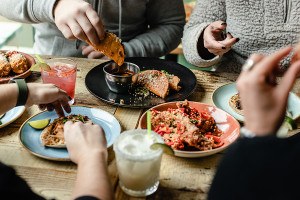Dining Out: Fishing for Compliments
Tim Cushman has made a stunning debut with O Ya. Exactly coincident with two new books detailing the worldwide craze for sushi—The Zen of Fish, by local boy Trevor Corson, and The Sushi Economy, by Boston contributor Sasha Issenberg—O Ya offers original and memorable takes on sushi that draw on French, Thai, Vietnamese, and other culinary vocabularies but stay rooted in the flavors and techniques of Japan. Although the three Japanese chefs behind the long, high wooden bar at O Ya will make perfectly serviceable traditional sushi on request, you’d be wasting their time and your money. If you want straightforward, go to Oishii, and be prepared to come out considerably poorer. The O Ya chefs are there not to display their own bravura but to assemble Cushman’s creations, which are united by painstaking attention to detail and surprise.
Like many debuts that seem to come from nowhere, Cushman’s has been years in the making—more than 25, in fact, since he moved from Boston to L.A. with a Berklee degree in jazz guitar and no job. In that time he’s worked with sushi masters around the world: Nobu Matsuhisa, when he was starting out in a tiny space that happened to be across the street from a restaurant Cushman was opening; the Japanese protégé of Masa Takayama, now of Manhattan’s stratospherically expensive Masa; and chefs in Japan, Hong Kong, Italy, France, and Mexico. Bolstered by that long apprenticeship, Cushman and his wife, Nancy (who’s trained as a sake sommelier), launched O Ya as its sole owners—no investors to offer “helpful” advice, no publicity, no reservations for any of the 20 seats at the bar or the 20 at tables.
The first night I found my way to O Ya, on a street I’d never heard of (East Street, in the Leather District), in a handsome old brick firehouse I’d never seen, I pulled up a comfortable stool and prepared to order the familiar nigiri I reflexively hunger for. Nothing doing. The double-sided menu had descriptions like “spicy mentaiko mayo, negi, sesame,” “white soy ginger, myoga, lemon oil,” and “yuzu kosho aioli, squid-ink bubbles.” Out of timidity and the pretext of doing a careful comparison, I asked the waitress—the best-informed, most helpful server I’ve encountered in a long time—to bring side-by-side nigiri, plain and fancy.
That was a mistake. The plain nigiri was fine but unexceptional. All the excitement lay in those opaquely described O Ya originals. Take a beginner’s example: wild bluefin maguro tuna with soy-braised garlic and micro greens ($9). Perennially popular fat maguro tuna is subtly transformed with garlic-infused soy sauce and greens napped with garlic oil. I loathe a heavy hand with garlic, especially when it’s over the hill; this was lively and fresh. Wild ivory king salmon is always a treat but, like any food prized for its fat, can quickly grow wearying. Not this preparation, though, which features toasted garlic and the kick of homemade red Thai curry paste with palm sugar, fish sauce, and coconut milk ($14), dusted with sesame seeds and both normal and micro lemongrass. Something this good, right, and surprising makes you go, Wow.
Another easy-to-love choice: salmon tataki with torched tomato, smoked salt, and onion aioli ($8). The “torching” sears the tomato and salmon ever so lightly, and it’s fun to watch, too. The salt provides the barest hint of smoke, and the onion aioli—sweet with mirin and rice wine vinegar, the onions first rinsed so as not to be too pungent—manages to pervade but not domineer.
Cushman makes pretty much everything by hand, even the dried-fish base dashi for his miso ($8). For the soup, he adds the standard cubes of tofu and shiitake just before serving, plus some chanterelles and green onions to brighten the broth. It’s a better version of a taste you know. So is his clam chowder with tempura bits ($9), porky with drizzled kurobuta pork fat and cracklings. Chowder connoisseurs need to sample this thick, rich rendition of the New England combination of clams and potato. Also familiar yet enhanced is the house salad of handcut red and green cabbage with a Thai-flavored dressing and refreshing Vietnamese mint and lemon rind ($8), sprinkled with spiced boiled walnuts.
I was persuaded more by the riffs within Japanese and broader Asian vocabularies than by the additions of western ingredients like truffles, butter, and shallots (though certainly the Japanese have adopted mayo with fervor). Truffle oil makes its typically unwelcome appearance in a few dishes, including a sushi of cute La Ratte potato chips ($14), named for the cult French heirloom fingerling, with from-scratch truffle mayonnaise and fresh black truffle sliced on top. Cushman also hasn’t resisted the trend of warm foams, which he calls “bubbles”; while I didn’t order the odd-sounding squid-ink foam over fried Kumamoto oysters ($11), I did try the sesame “froth” over a meaty grilled sashimi of chanterelles and shiitakes with homemade soy and rosemary-garlic oil ($15)—a spectacular-looking dish, and a solid vegetarian entrée.
In his pent-up zeal, Cushman has opened with far too lengthy a menu. The intricate handwork for almost everything on it—Cushman told me he’s making 75 sauces—keeps prices high, though not unmanageable. I can imagine O Ya as a splurge once every few months instead of once a year, the latter being the way I think (probably unfairly) of Oishii. A strategy for a decent-size, non-break-the-bank O Ya dinner would be one or two nigiri or a soup followed by a meat dish and then a salad, with sashimi saved for special nights. Maybe Cushman will streamline the overenthusiastic, not to mention overwhelming, selection by offering his own version of an omakase, or chef’s-choice option—the kind that changes nightly, delights and enthralls you, and zaps you with a huge check at the end.
But he’d have to open another room for that, or take up precious spots at the bar—spots I want for my own future explorations. I’ve already charted out upcoming visits, as if preparing for an exciting trip. I need to get through more of the meats—the swaths of menu devoted to Wagyu beef, for instance—to try something other than the plump chicken-thigh yakitori with celeriac purée and burgundy black truffle ($16), and to overcome my greed for rice and further test the sashimi offerings. I’ll know not to bother with desserts, which are as meticulously made and thoughtful as the rest of the menu but are not very good (crumbled tempura bits are more effective in chowder than over berries in a soy-milk mascarpone custard, $12). And then there are the sakes, which Nancy Cushman curates based on years of study. There’s much to sample and learn, and if I can afford it, I want to learn it all. Meanwhile, I’ll be telling every food adventurer I know to head to O Ya.


